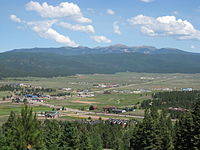
Photo from wikipedia
Abstract This study focuses on historical mountain villages in Japan. Generally, most of these villages are composed of traditional wooden buildings, and their surrounding environments are very traditional features. However,… Click to show full abstract
Abstract This study focuses on historical mountain villages in Japan. Generally, most of these villages are composed of traditional wooden buildings, and their surrounding environments are very traditional features. However, because of their susceptibility to fire damage and difficulties relating to their renewal and sustainment, these traditional wooden structures pose severe fire risks to the mountain villages as a whole. This paper takes the Hanazawa preserved historical mountain village in Japan as the research object. First, through multiple surveys, the fire safety characteristics and weaknesses of this village are investigated. Second, these fire safety characteristics are then analyzed with special attention given to the perception of cooperation and fire extinguishing capabilities of the residents. Based on these findings, (1) high-performance, low-cost, and easy-to-operate firefighting equipment requiring less modification to the buildings is introduced into the village. Moreover, the environmental traits of the historical village are also considered, and (2) an improvement plan for the water supply is proposed. Finally, through the experimental testing of firefighting equipment in the local conditions, specific non-damaging fire safety strategies are suggested that protect the structural integrity of the wooden buildings, and the historical and cultural value of historical villages, which mainly consist of a fire information network, a collective help initial-fire-response system, and public and collective assistance for suppressing the fire spread, are developed.
Journal Title: International journal of disaster risk reduction
Year Published: 2021
Link to full text (if available)
Share on Social Media: Sign Up to like & get
recommendations!